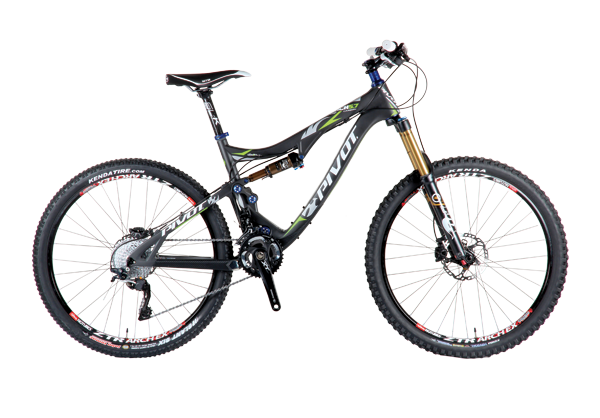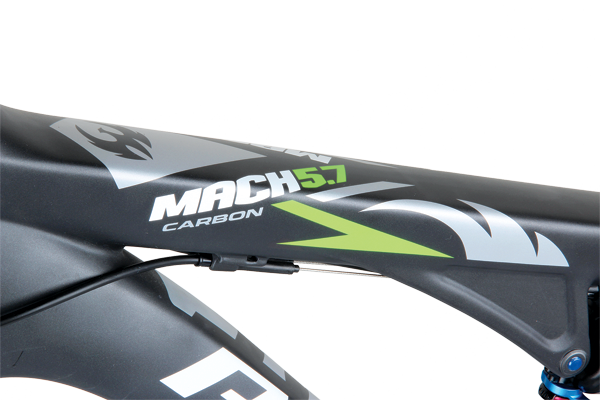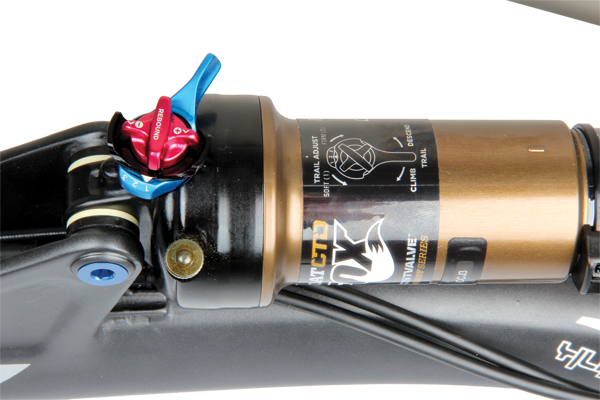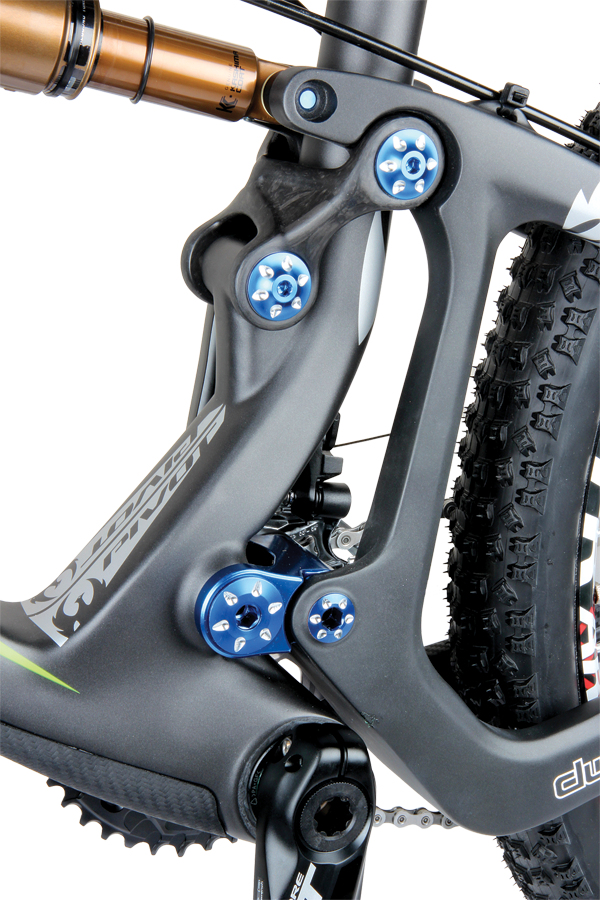Pivot Mach 5.7 Carbon
 Of late there’s been an overwhelming focus on new wheel sizes. It’s enough to have you thinking that any 26-inch wheeled bike is inherently and unavoidably inferior. Forums are loaded with talk of new 29-inch and 650B bikes, along with a good deal of bemoaning directed at brands that haven’t released a model to suit one of these new-school wheel sizes.
Of late there’s been an overwhelming focus on new wheel sizes. It’s enough to have you thinking that any 26-inch wheeled bike is inherently and unavoidably inferior. Forums are loaded with talk of new 29-inch and 650B bikes, along with a good deal of bemoaning directed at brands that haven’t released a model to suit one of these new-school wheel sizes.
Pivot is a brand that’s known to be a little edgy. They aren’t shy of doing something that sits outside of the box and they were a driving force behind new systems such as high-direct mounted front derailleurs, wide press-fit internal bottom brackets and integrated headsets. These designs weren’t introduced to be trendy or to sell some proprietary new components. Rather, Pivot’s founder Chris Cocalis pushed for these now commonplace concepts for a purpose; they allowed him the design flexibility that he needed to optimise his version of the highly reputed Dave Weagle designed DW-link suspension system—it was a simple means to an end.
So how come this forward thinking brand doesn’t have a long travel 29er or a 650B model in their line-up? Well there’s no doubt that Chris and the rest of the Pivot team are working on something but they aren’t rushing into it. Long before 650B became fashionable, Pivot was being hounded to make a DW-link downhill bike. While they could have sold truckloads at the time, it took years for them to create such a beast (now it exists and it’s called the Phoenix). Everything they do is thoroughly designed, solidly engineered and they won’t jump headlong into something just for the sake of being first. No doubt they’ll come up with a long-travel larger wheeled bike at some point, but it’ll only happen when they are good and ready.

New but Not
So where does that leave them in the meantime? Well for a few years now, the Mach 5.7 has been one of their best sellers. It’s gained quite a reputation as a top-performing all-rounder and just last year they released the carbon version that we’ve got on test here. As the only 26er on test in this issue, how does it fare—is it simply overwhelmed in this day and age of larger wheeled bikes?
Before we get onto the actual performance, let’s take a look at the general features and stats on this relatively new model. After five years of focusing on alloy frames, the Mach 5.7 was Pivot’s first venture into carbon. While Chris Cocalis has an extensive history of working with carbon (he has designed 750g carbon road frames with Spanish brand BH), he didn’t want to launch a carbon Pivot until the technology was well and truly up to the task. The Mach 5.7 Carbon is said to be 10-15% stiffer than the aluminium version, around 300g lighter and the construction aims to offer excellent impact resistance.

On our scale
s the frame and shock came in at 2,530g. That makes it around 200g lighter than the new Yeti SB66 Carbon and the Santa Cruz Blur LTc, and close to the same weight as the Ibis Mojo SLR. On the whole it’s very competitive for a frame that offers 145mm of travel. The finish is first rate too; feel around inside the bottom bracket or head tube and you’ll find that the tubes are smooth both inside and out, with no wrinkled carbon or excess resin. The tube profiles are huge – especially around the head tube and bottom bracket – making the alloy version of the 5.7 look particularly malnourished. In addition to the bigger tubes, the carbon frame also features wider spacing on the linkage mounting points to boost both stiffness and bearing longevity.
Features-wise the frame ticks just about all the boxes for a modern all-mountain bike. The geometry is nice and relaxed with a 67-degree head angle, short 428mm chainstays and a stable but not excessively long 1,122mm wheelbase (for a medium frame). If anything, the 71-degree seat tube angle is a little on the slack side, so a zero-offset post will be in order if you plan on tackling steep climbs. While some brands are trending towards really long top tubes and front centres with short stems to keep the reach in check, the 5.7 is more towards the middle of the bell-curve. That means you so you may need a slightly longer stem (maybe 80-90mm) if you don’t want to be cramped for more trail/XC oriented riding.

Up front, a tapered semi-integrated headset lets you get the bars as low as you could want, even with long travel forks. It uses a 142x12mm thru-axle on the rear and you’ll find cable guides in place for a dropper post. It’s also great to see that there’s room for a full-sized bottle within the frame, plus a second mounting point under the down tube—a brilliant feature for shorter rides where you mightn’t want to lug a hydration pack. You even get an easy to use sag marker on the shock to make the initial setup a breeze. All good stuff but there’s one obvious omission from the all-mountain wish-list; there are no ISCG mounts at the bottom bracket for a chain guide.
Pivot does offer a bolt-on adaptor for the alloy version but not for the 5.7 Carbon—the down tube is so wide that there’s simply no room. It seems odd that they offer guide mounts on the new 100mm travel carbon 29er (the 429c) but not on this all-mountain/trail bike, but that’s the way it is. According to Chris, pro riders who are riding this bike in enduro events simply run a top guide combined with a clutch-style rear derailleur, bashguard and a chainstay mounted retention device (like the one made by Bionicon). This setup offers a simple and effective solution that’s in keeping with the lightweight nature of the Mach 5.7.

Most boutique brand carbon suspension frames sell for $3,500 and up, so the $3,000 asking price for the Mach 5.7 Carbon seems quite reasonable—it’s only $500 more than the alloy version. It can also be purchased as a compete bike with a number of build options. These start with the $6,599 XT Pro build (as pictured) which comes with a Shimano XT 2x10 groupset, an upgraded XTR Trail rear derailleur, Stan’s Arch wheels and a Factory level 150mm travel Fox Float CTD fork—it’s all really good gear that performs without fault. In this guise the Mach 5.7 Carbon tipped the scales at just 11.4kg excluding pedals. Other options include a SRAM X.0 Trail build for $6,999, SRAM XX-1 at $8,299 and full Shimano XTR for $8,949. With any of these builds, you can opt in for a dropper post upgrade—that’d be a really worthwhile addition on a bike such as this.
Anti-What?
Now onto the most important matter; how did it ride? On the trail, the character of this bike is clearly defined by the DW-link suspension. It’s a short-link four-bar system that utilises drivechain forces to provide ‘anti-squat’. In basic terms, when you load up the pedals, the chain pulls back against the swingarm and stiffens the suspension slightly to resist unwanted bob. Stomp harder when climbing and the suspension stiffens even more. Descend or pedal along the flat and there’s less anti-squat, so the suspension is free to move. Virtually every modern suspension design uses anti-squat to some degree; it’s just that this force is more prevalent in the DW-link—it’s even got more anti-squat than many other popular short-link four-bar systems such as the VPP-2 as used by Santa Cruz and Intense. Strong anti-squat characteristics mean that you are not reliant on platform damping to filter out unwanted movement, so the suspension can be soft and free to soak up the terrain.

This theory certainly plays out on the Mach 5.7. The leverage ratio early in the travel combines with a really light valving tune to make the Fox CTD shock incredibly supple. Once set with the recommended 30% sag, it takes next to no effort to get the shock moving—just push down on the saddle with your thumb and the suspension will compress. With such smoothness and so little force required to get the suspension moving, the small bump compliance is unbelievable—it’s as if the 5.7 has the coil sprung back end of a full-on gravity racer, at least at the start of the travel anyway. This thing virtually erases small bumps, ripples and just about anything else; a real magic carpet ride.
Most trail bikes have more breakaway force than the Mach 5.7 and they usually need it. Without some initial stiction, they’d suffer when it came to pedalling. In this regard the Pivot seemingly defies logic; it’s so soft that you can’t help thinking it will pedal horribly. However, within a few strong pedal strokes you realise that this simply isn’t the case. Under power this bike feels responsive and bounds forward like a good 11kg cross-country bike should—and that’s with the CTD shock set in the super supple ‘descent’ mode!

That’s not to say that the rear end doesn’t budge when you’re out of the saddle. Look between your legs and you’ll see that the shock moves around a bit but it really doesn’t feel inefficient or soggy under foot. As you stomp on the pedal during the downstroke, the chain tension maximises the anti-squat and the bike drives forward without any feel of mush. As you get to the dead-spot at the bottom of the pedal revolution (six o’clock/12 o’clock), your body weight is still travelling downwards but the unevenness in your pedal stroke means that the anti-squat drops off; that’s when the suspension moves, but as you’re not applying power to the rear wheel at this point, the movement isn’t causing a loss in efficiency.
Of course you can always add some pro-pedal damping by using the middle ‘trail’ setting on the CTD shock but it really isn’t necessary—just pedal this bike in ‘descent’ mode and it climbs, sprints and flat-out goes. Best of all, it achieves this efficiency without manually activated travel adjustments, remote lockouts, platform damping or stiff initial travel to cover up a design that’s inherently inefficient. With the Pivot you’ll always have 145mm of supple travel at your disposal; it’ll keep the rear tyre glued to the trail 100% of the time, both uphill and down.

Now too much of a good thing can be bad, and that’s certainly the case with anti-squat in a suspension design. Anti-squat is created through ‘chain-growth’, which means that the chainstays get longer as the suspension is compressed. Too much chain-growth can become noticeable when you pedal over bumpy terrain, as you may feel the chain tugging back on the pedals as the suspension moves. Additionally, by stiffening under power the suspension becomes less able to follow the terrain, resulting in compromised comfort and traction.
The DW-link (and some other short-link designs) side-step this potential pitfall by using a variable axle-path—something that’s just not possible with a single pivot design. In the case of the Mach 5.7, the first third of the travel is decidedly rearward to deliver strong anti-squat for better pedalling performance. As you go deeper, the wheel arcs in to a more vertical path in an effort to minimise the negative effects when pedalling over rougher ground. I could detect a small amount of kickback on rock-steps whilst pedalling lightly in the small chainring, however I had to pay really close attention to notice it—it certainly wasn’t enough to disrupt my pedalling rhythm.

With lots of torque going through the drivechain on a steep climb, you can really feel the rear suspension firm up—it actually causes the back end to rise and helps to keep your weight forward when climbing. There may be a slight loss in bump compliance (most noticeable on rock-stepped climbs) but for me the compromise was worth it for the gain in pedalling efficiency. If anything the chain torque helps to drive the rear tyre into the ground and gain traction.
Some like soft and hyperactive suspension for seated climbing up root-riddled trails. If that sounds like you, the DW-link mightn’t be your ideal match but I feel that Pivot has achieved a great balance between efficient pedalling performance and overall suspension activity.
Weagle Worship
Once the climb has been dispatched with DW-link efficiency, the real fun begins. The chain-growth that we’ve just described comes about through a more rearward movement of the wheel-axle. In addition to assisting on the climb, the distinctly rearward axle-path makes the suspension better able to absorb square edge bumps. This effect combined with the super supple suspension ensures that the 145mm travel Pivot irons out the trail like a much longer travel bike. Prior to testing this bike, I was on the new Santa Cruz Tallboy LTc; a 135mm travel 29er that destroyed rock gardens like few I’ve ridden before. While the big-wheeled Santa Cruz had the edge when it came to clambering up rock ledges at lower speeds, the small-wheeled Pivot ploughed through high-speed square-edge rocks with even greater ease. Perhaps it was the extra 10mm of travel, the lighter shock tune and the more rearward axle-path all combined; whatever the case, the Mach 5.7 lifted my descending capabilities a notch further again.
One thing that makes the Pivot feel so good is the linearity of its travel. Some bikes will only use 75% of their travel unless you huck from a cliff. The 5.7 will use all 145mm of travel on any moderately rough trail. Whilst this could be a recipe for disaster when you do drop-to-flat or mistime a jump, the Boost-Valve equipped Fox shock always seems to mitigate the situation. I could use all the travel by riding off a gutter, yet I never felt the back end bottom harshly whilst on the trail—like magic! That said, the Mach 5.7 has its limits if you’re taking on really big jumps and drops. There’s certainly a place for more progressive bottom-out resistant suspension; that’s why Pivot employs a more progressive suspension curve on their 167mm travel Firebird.
Out on the trail, the Mach 5.7 was a barrel of laughs. The suspension turns rocks and roots into a pitter-patter under the tyres—you know it’s there but the bike remains poised and calm no matter what you throw it at. The new generation 150mm travel Fox CTD fork is a surprisingly good match for the rear end and the 67-degree head angle strikes a nice balance between descending confidence and manageability when climbing. As always the 26-inch wheels give the bike a sense of agility and liveliness that’s often lost on a long travel big-wheeler.
In one bike-swap session my riding buddy summed it up well; he described it as a larrikin bike. Yep, this bike turns you into a hoon! It makes you want to go fast and push your limits; whenever an opportunity arises it’ll have you hammering through the rocks, popping off lips and milking the trail for everything it can give—it’s a lot of fun. On the flipside, it also climbs with the efficiency of a much shorter travel bike and I wouldn’t hesitate at using the Mach 5.7 in XC and marathon events; it’s a great all-rounder and I feel that this is one test bike that mightn’t be going back…
Thumbs Up
Awesome suspension performance
Efficient to pedal
Light and stiff
Thumbs Down
No ISCG tabs
Awkward to service press-fit bottom bracket
Spindly stem looks mismatched
Specifications
Frame: Mach 5.7 Carbon
Shock: Fox CTD Trail Adj 145mm travel
Fork: Fox Float 32 CTD Trail Adj 150mm travel
Headset: Pivot Sealed 1 1/8 - 1 1/2
Handlebars: FSA SL-K carbon riser 685mm
Stem: FSA SL-K, 100mm
Shifters: Shimano XT
Front Derailleur: Shimano XT
Rear Derailleur: Shimano XTR Trail
Cassette: Shimano XT 11/36 10-speed
Chain: Shimano XT
Cranks: Shimano XT 26/38
Bottom Bracket: Shimano XT Press-Fit
Pedals: N/A
Brakes: Shimano XT Trail
Wheels: No-Tubes ZTR Arch EX
Tyres: Kenda Slant Six (F) / Nevagal (R)
Saddle: WTB Vigo Race
Seatpost: FSA SL-K carbon
Weight: 11.4kg without pedals (Medium frame 2,530g)
Available Sizes: S, M (tested), L and XL
Price: $6,599 (XT Pro build)
Distributor: JetBlack Products (02) 4560 1200 / www.jetblackproducts.com.au






